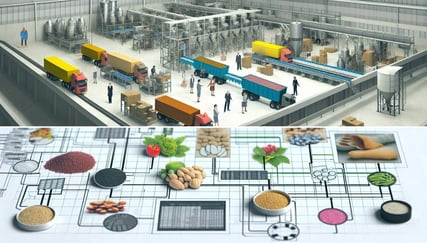Supply Chain Network Design and Planning
Precision, efficiency, and quality are essential in food and beverage manufacturing, the backbone of success lies in an optimized supply chain network design and planning. For Operations Directors navigating this landscape, the integration of advanced planning tools like PlanetTogether with robust ERP, SCM, and MES systems such as SAP, Oracle, Microsoft, Kinaxis, Aveva, and others can be transformative.
In this blog, we'll look into the nuances of supply chain network design and planning, exploring strategies, challenges, and the crucial role of technology integration in driving operational excellence.

Understanding Supply Chain Network Design and Planning
Supply chain network design and planning encompass the strategic and tactical decisions involved in structuring the flow of materials, products, and information from suppliers to end consumers. It involves a holistic approach that considers factors such as sourcing, production, inventory management, distribution, and transportation.
Key Components of Supply Chain Network Design and Planning:
Demand Forecasting: Accurate demand forecasting serves as the foundation for effective supply chain planning. By leveraging historical data, market trends, and predictive analytics, operations directors can anticipate demand fluctuations and adjust production and inventory levels accordingly.
Inventory Optimization: Balancing inventory levels is a delicate task, as excess inventory ties up capital, while insufficient inventory leads to stockouts and customer dissatisfaction. Through advanced algorithms and optimization techniques, operations directors can determine optimal inventory levels across the supply chain network, minimizing carrying costs while ensuring product availability.
Production Planning and Scheduling: Efficient production planning and scheduling are essential for maximizing resource utilization and minimizing lead times. By aligning production schedules with demand forecasts and capacity constraints, operations directors can optimize production efficiency and meet customer demand in a timely manner.
Transportation Management: Transportation plays a critical role in supply chain logistics, influencing lead times, costs, and customer satisfaction. Operations directors must design efficient transportation routes, select the appropriate modes of transportation, and coordinate shipments to minimize transit times and reduce freight costs.
Supplier Collaboration: Collaborating closely with suppliers is essential for maintaining a resilient and agile supply chain. By establishing strong relationships, sharing demand forecasts, and implementing vendor-managed inventory (VMI) programs, operations directors can improve supply chain visibility and responsiveness.

Challenges in Supply Chain Network Design and Planning
Despite its importance, supply chain network design and planning present several challenges for operations directors, including:
Complexity: Food and beverage supply chains are inherently complex, with multiple stakeholders, diverse product lines, and stringent regulatory requirements. Navigating this complexity requires sophisticated planning tools and robust analytics capabilities.
Uncertainty: The dynamic nature of the food and beverage industry introduces uncertainty into supply chain planning, stemming from factors such as seasonal demand fluctuations, supply chain disruptions, and changing consumer preferences. Operations directors must develop agile planning processes capable of adapting to unforeseen events.
Integration Silos: Siloed data and disparate systems pose a significant barrier to effective supply chain planning. Without seamless integration between ERP, SCM, MES, and planning tools like PlanetTogether, operations directors struggle to access real-time information, leading to suboptimal decision-making and inefficient operations.

The Role of Technology Integration
To overcome these challenges and unlock operational efficiencies, operations directors must prioritize the integration of advanced planning tools with their existing ERP, SCM, and MES systems. By integrating solutions like PlanetTogether with platforms such as SAP, Oracle, Microsoft, Kinaxis, Aveva, and others, operations directors can achieve the following benefits:
Real-time Visibility: Integration enables seamless data exchange between planning and execution systems, providing operations directors with real-time visibility into supply chain performance metrics, inventory levels, and production schedules.
Collaborative Planning: Integrated planning tools facilitate collaboration and communication across functional departments and external partners, enabling synchronized planning efforts and fostering alignment between demand forecasts, production schedules, and inventory levels.
Predictive Analytics: By combining historical data with advanced analytics capabilities, integrated planning solutions empower operations directors to generate accurate demand forecasts, identify trends and patterns, and simulate various scenarios to assess the impact of different strategies on supply chain performance.
Optimized Decision-making: Integration enables operations directors to make informed decisions based on comprehensive, up-to-date information, allowing them to optimize production schedules, inventory levels, and transportation routes to meet customer demand while minimizing costs and maximizing efficiency.
Agile Response to Change: Integrated planning tools provide operations directors with the agility to respond quickly to changing market conditions, supply chain disruptions, and unforeseen events, enabling proactive risk management and ensuring business continuity.
In food and beverage manufacturing, success hinges on the ability to design and plan a resilient and efficient supply chain network. For Operations Directors, integrating advanced planning tools like PlanetTogether with ERP, SCM, and MES systems is essential for overcoming complexity, uncertainty, and integration silos, unlocking operational efficiencies, and driving strategic growth.
By embracing technology integration and adopting a holistic approach to supply chain network design and planning, operations directors can position their organizations for success in an increasingly competitive marketplace, delivering superior customer experiences, maximizing profitability, and driving sustainable growth.
Are you ready to take your manufacturing operations to the next level? Contact us today to learn more about how PlanetTogether can help you achieve your goals and drive success in your industry.
Topics: Real-time Visibility, PlanetTogether Software, Advanced Predictive Analytics, Integrating PlanetTogether, Collaborative Planning, Agile Response to Changes, Optimized Decision-Making, Food and Beverage Manufacturing




















LEAVE A COMMENT